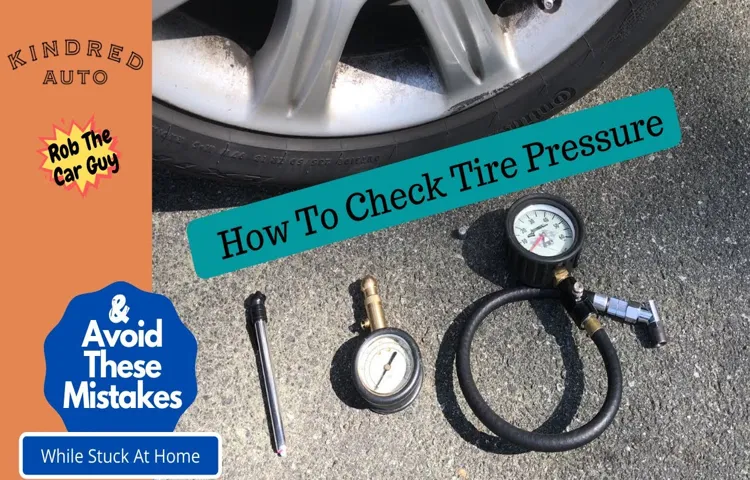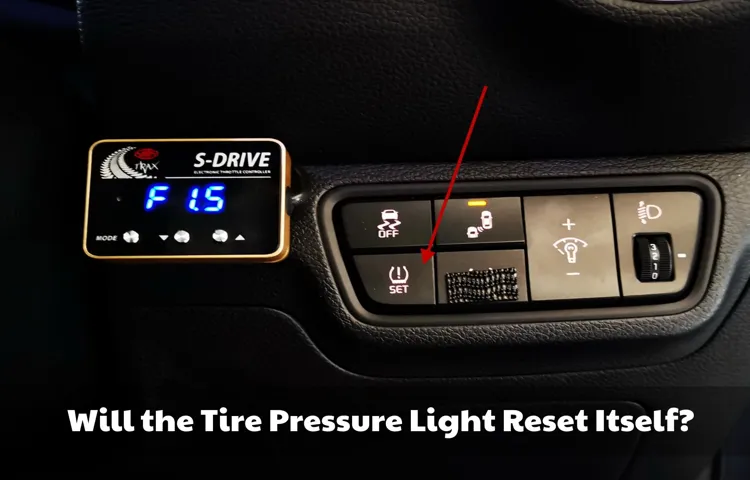Driving on underinflated tires is not only dangerous but also harmful to your vehicle’s longevity. That’s why it’s crucial to monitor your tire pressure regularly. However, what happens when you can’t seem to get a reading on your tire pressure gauge, despite following the manufacturer’s instructions? It can be puzzling.
Why is my tire pressure not showing? There could be several reasons for this, including technical glitches, ambient temperature, or a faulty sensor. Not to worry, though – we’ve got you covered. In this blog post, we’ll walk you through the possible causes of a tire pressure reading issue and how to fix it to ensure your vehicle’s safety and optimal performance.
Possible Causes
If you’re wondering why your tire pressure isn’t showing up on your dashboard, there could be a few possible causes. Firstly, it could be an issue with the tire pressure sensors themselves. These sensors can malfunction or become damaged over time, which can cause them to stop communicating with your car’s computer.
Another possibility is that there’s a problem with your car’s electronic system. A faulty wiring harness or computer can prevent your car from accurately reading the tire pressure sensors. Lastly, it’s worth considering the age and condition of your tires.
If your tires are old or worn out, they may not be able to maintain the proper air pressure, which could result in them not registering on your car’s dashboard. If you’re unsure of the cause of the problem, it’s always best to get your car checked out by a professional mechanic.
Loose or Damaged Sensor
A loose or damaged sensor can cause various issues in your vehicle. One of the possible causes of a loose sensor is when it becomes disconnected from its mounting bracket due to prolonged use or vehicle vibrations. On the other hand, a damaged sensor can occur due to harsh road conditions or improper handling at the time of installation.
It’s crucial to fix loose or damaged sensors immediately as they can lead to more significant problems if left unaddressed. For instance, if a damaged sensor is left unattended, it can give the wrong readings to the engine control module, which can cause the engine to misfire, lose power or become less fuel-efficient. To prevent sensor issues, it’s essential to have your vehicle serviced regularly.
A qualified mechanic can identify any wear and tear on sensors and make the necessary repairs. Moreover, during servicing, the mechanic can check for any stored codes in the vehicle’s computer system to determine if any sensors need repair. In conclusion, if you suspect that your vehicle’s sensor is loose or damaged, don’t ignore it.
Address the issue promptly to avoid more significant problems in the future. And remember to have your vehicle serviced regularly to prevent sensor issues from occurring in the first place.

Dead Battery in Sensor
A dead battery in a sensor can be a frustrating problem to encounter. There are several possible causes for this issue. Firstly, the sensor may have been left on for an extended period of time without being used, causing the battery to drain.
Secondly, the battery may have reached the end of its lifespan and needs replacing. A third possible cause is that the sensor may have been exposed to extreme temperatures, causing the battery to drain or malfunction. It’s important to note that some sensors may use disposable batteries, while others may have rechargeable ones.
In any case, it’s always a good idea to check the sensor’s user manual for guidance on replacing the battery or troubleshooting the issue. By doing so, you can quickly get your sensor back up and running and avoid further frustration.
Malfunctioning Sensor
A malfunctioning sensor can be a frustrating problem for any homeowner. There are several possible reasons for malfunctioning sensors, including damage to the sensor, water damage, wiring issues, and interference from other devices. Damaged sensors can occur from a variety of sources, including physical damage from weather conditions, vandalism, or wear and tear over time.
Additionally, water damage can cause sensors to malfunction, particularly if there is a leak in your home’s plumbing system. Wiring issues can also cause sensors to malfunction, particularly if the wiring is not properly installed or has become damaged over time. Finally, interference from other devices can also cause sensors to malfunction, particularly if there are other electronic devices in close proximity.
No matter the cause of the malfunction, it is important to address the issue promptly to ensure that your home’s security and safety are not compromised.
System Error or Glitch
When you encounter a system error or glitch, it can be frustrating and confusing. But what causes these issues? There are several possible reasons why your computer or software might be acting up. One common cause of system errors is outdated or malfunctioning hardware.
If your computer’s components aren’t working correctly, it could cause issues with your software or the operating system. Another possible cause is a software bug or coding error. This can happen if there’s a mistake in the programming that causes unexpected behavior.
Additionally, viruses or malware can cause system errors by damaging files or interfering with normal operations. Ultimately, the key to fixing a system error is to identify the underlying cause and take steps to address the issue.
Troubleshooting Steps
If you’re wondering why your tire pressure isn’t displaying on your dashboard, there are a few different troubleshooting steps you can take. First, check to make sure your car is turned on and that the tire pressure monitoring system (TPMS) is enabled. If it is, try manually resetting the system by holding down the TPMS reset button for several seconds.
If this still doesn’t work, there may be a problem with one of the sensors in your tires. Check for any visible damage or signs of wear and tear and consider getting them replaced if necessary. Additionally, make sure your tires are properly inflated to the recommended pressure.
If you’re still having issues, it may be best to take your car to a professional mechanic to diagnose and fix the problem. By taking these steps, you can ensure that your TPMS is functioning properly and that you’re driving with safe and properly inflated tires.
Check for Loose or Damaged Sensors
One of the common troubleshooting steps when it comes to sensors is to check for loose or damaged components. It’s not uncommon for sensors to become loose or disconnected, which can cause inaccurate readings and lead to system malfunctions. When you’re inspecting your sensors, make sure that all connections are tight and secure.
If you notice any damage to the wiring or components, you may need to replace the faulty parts in order to ensure proper sensor function. It’s important to take the time to inspect sensors regularly, as catching any issues early on can save you time and money down the road. By following these troubleshooting steps and remaining vigilant with your inspections, you can help ensure that your sensors operate smoothly and effectively.
Replace Sensor Batteries
Replacing the batteries in your sensor is a simple troubleshooting step that can help restore functionality. When a sensor stops working properly, the first thing you should check is its batteries. Over time, the battery power weakens and eventually dies out.
By replacing the batteries, the sensor will be able to function properly again. Before replacing the batteries, make sure that you have the correct type of battery for the sensor. If the sensor still doesn’t work after replacing the batteries, you may need to check the sensor’s settings or consult the manufacturer’s instructions.
Keeping a stock of replacement batteries on hand can help you quickly restore your sensors when they stop working, without any delays. Replacing sensor batteries is an easy and cost-effective solution that can help save you time and money in the long run. So, if your sensor stops working, replacing the batteries is the first step to troubleshooting the issue.
Reset System
When you encounter issues with your computer, one of the most common solutions is to reset the system. This process can help fix various problems, such as frozen programs, slow performance, or error messages. However, before you reset your system, it’s crucial to save your important files and data as the reset will wipe everything from the hard drive.
Once you’ve backed up your data, you can proceed with the reset process. This typically involves accessing the system settings or using a recovery mode to reinstall the operating system. Keep in mind that resetting your system may take some time, and you may need to reinstall your programs and drivers afterward.
However, it’s often a reliable solution to fix annoying issues that may be affecting your productivity or enjoyment of using your computer.
Seek Professional Assistance
If you are facing a technical issue with your computer, it’s natural to feel overwhelmed or frustrated. However, instead of giving up or causing more damage, seek professional assistance to troubleshoot the problem properly. Troubleshooting is the process of identifying and solving problems, and it requires expertise and experience to do it effectively.
You can either contact the manufacturer’s technical support team or take your computer to a local repair shop. Professional technicians have access to specialized tools and software that can detect and resolve issues quickly and efficiently. They can also provide you with valuable advice on how to avoid future problems and maintain your computer’s performance.
Don’t ignore warning signs or assume that you can fix everything yourself. Sometimes, seeking professional assistance is the best course of action for your computer’s health and longevity.
Preventative Measures
One of the reasons why a tire pressure may not be showing is due to a faulty sensor. Sensors can malfunction from time to time, and it is recommended to have them replaced every few years. Another common issue is a leak in the tire.
Leaks can cause a drop in tire pressure, and if left unfixed, they can lead to a flat tire or even a blowout. To prevent this from happening, it is important to maintain your tires by regularly checking their pressure and performing visual inspections for any signs of damage or wear. Additionally, keeping your tires properly inflated can increase their lifespan and improve fuel efficiency.
It is a good idea to keep a tire pressure gauge handy in your car so that you can check your tire pressure on the go and make any necessary adjustments. Remember, preventative maintenance can save you the hassle and expense of dealing with a flat tire or blown-out tire on the side of the road.
Regular Maintenance
Regular maintenance is the key to keeping your equipment running smoothly and efficiently. Preventative measures can save you time, money, and frustration in the long run. By scheduling regular checks, cleaning, and repairs, you can avoid costly breakdowns and unexpected downtime.
It’s important to keep your equipment well-maintained to ensure that it performs at its best, and to extend its lifespan. Neglecting regular maintenance can lead to larger problems down the line, which can be much harder and more expensive to fix. Think of it like taking care of your car – regular tune-ups and oil changes keep it running smoothly, and prevent major issues from arising.
The same principle applies to your equipment. Investing in preventative measures now can save you from major headaches later on.
Monitor Tire Pressure Manually
When it comes to taking preventative measures for tire maintenance, manually monitoring tire pressure is essential. Checking tire pressure once a month is crucial as it can help prevent potential safety hazards and prolong the life of your tires. Low tire pressure can increase the risk of a blowout or accident, while overinflated tires can lead to reduced traction and uneven tire wear.
To check the pressure of your tires manually, you’ll need a tire pressure gauge, which can be found at any auto parts store or online. Simply insert the gauge into the valve stem of each tire and check the reading against the recommended psi for your vehicle, which can be found in the owner’s manual or on a sticker located on the driver’s side door jamb. By regularly monitoring your tire pressure, you can ensure a smooth and safe driving experience while simultaneously extending the life of your tires.
Invest in High-Quality Sensors
Investing in high-quality sensors is one of the best preventative measures that you can take to protect yourself and your assets. Whether you’re concerned about home security, workplace safety, or environmental monitoring, high-quality sensors can provide you with the peace of mind that you need. These sensors are designed to detect any potential hazards before they can cause any serious damage.
For instance, if you have a fire sensor in your home, it can quickly detect the presence of smoke and alert you of a potential fire. Similarly, if you have a water leak sensor installed, it can quickly detect any leaks in your plumbing and prevent potential flooding. By investing in high-quality sensors, you’re not only protecting your investments, but you’re also investing in your safety.
With the right sensors in place, you can rest easy knowing that you’re protected against any potential dangers.
Conclusion
Well, it seems as though your tire pressure monitor has decided to take a mental health day, leaving you in the dark about your tire pressure. Perhaps it’s just tired of constantly checking your tires and needs a break. Or maybe, like a rebellious teenager, it’s trying to test your ability to take care of your car without relying solely on technology.
Whatever the reason may be, don’t fret- take this as an opportunity to flex your old-school tire checking skills and show that monitoring system who’s boss!”
FAQs
Why is my tire pressure not showing on the dashboard?
There could be a number of reasons why your tire pressure isn’t showing on the dashboard. The most common reason is a malfunctioning sensor, low battery power in the sensor, or a faulty wiring connection. It’s best to take your car to a mechanic to diagnose the issue.
How often should I check my tire pressure?
It’s important to check your tire pressure at least once a month, as well as before any long trips or if you notice your tires are looking low or flat.
Can driving with low tire pressure be dangerous?
Yes, driving with low tire pressure can be dangerous as it can cause uneven wear and tear on your tires, affect your car’s handling and fuel efficiency, and increase the risk of blowouts or accidents.
What should I do if my tire pressure is low?
If your tire pressure is low, add air to your tires using a tire pressure gauge and an air compressor. Make sure to check your car manual or the tire sidewall for the recommended pressure level.
What is the recommended tire pressure for my car?
The recommended tire pressure can vary depending on the make and model of your car. You can find the recommended tire pressure in your car manual or on the tire sidewall.
Can over-inflated tires cause damage?
Yes, over-inflated tires can cause damage to your tires, affect your car’s handling, and increase the risk of blowouts or accidents. Make sure to check your car’s manual or the tire sidewall for the recommended pressure level.
Will my car’s fuel efficiency improve if I maintain the correct tire pressure?
Yes, maintaining the correct tire pressure can improve your car’s fuel efficiency, as it reduces rolling resistance and helps your tires run more efficiently.




